|
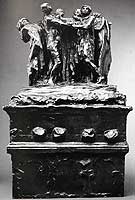 Rodin's
'Burghers of Calais' tell the story of the six distinguished citizens of
the French coastal town Calais, who in 1347, during the Hundred-Years War
with England, exposed themselves volunteerly into captivity of King
Edward III to save their town from extermination. Rodin's
'Burghers of Calais' tell the story of the six distinguished citizens of
the French coastal town Calais, who in 1347, during the Hundred-Years War
with England, exposed themselves volunteerly into captivity of King
Edward III to save their town from extermination.
Rodin won the commission for the monument of the town
Calais in January 1885 after his first maquette, distinguishing itself
from the more conventional designs presented by his five competitors, had been approved by
the Committee in November 1884. Propelled by his ambition to win this
public commission, the sculptor promised to deliver "six
sculptures for the price of one".
Rodin described his intentions as follows:
"It is the subject itself which (...) imposes a heroic
vision of all six figures being sacrificed to one single communicative
expression and feeling. The pedestal is triumphal, it has the rudiments of
an arch of triumph intended to uphold, not a quadriga, but human
patriotism, self-abnegation and virtue."
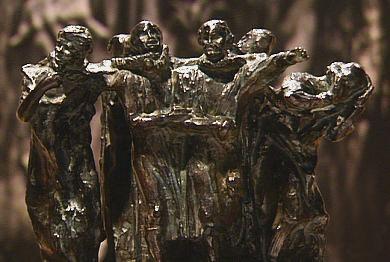 Rodin's
direct literary source is the chronological receit of historian Jean
Froissart (ca. 1333-1410), describing how King Edward demanded the six
citizens to appear bareheaded, only dressed with a shirt, with a rope
around their necks and the keys for the town in their hands. Rodin's
direct literary source is the chronological receit of historian Jean
Froissart (ca. 1333-1410), describing how King Edward demanded the six
citizens to appear bareheaded, only dressed with a shirt, with a rope
around their necks and the keys for the town in their hands.
Instead of focussing on the first of the citizens who
had volunteered, Eustache de Saint-Pierre, Rodin decided to portray six
individuals. Instead of idealising the dignity of their heroic sacrifice,
he revealed their misery and inner doubt and showed them in rough
sack-like clothes. Instead of setting up a traditional pyramidal
composition, he placed the six men on the same level, each of them
occupied by his own personal conflict: 'Pierre de Wissant', 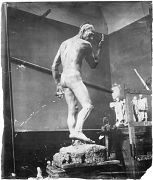 who,
on his slow procession towards death, turns round and lifts his right arm
back, just like setting free a bird (Rilke); 'Jean d'Aire', on the other
side of the monument, is standing upright with clenched hands but
stoically reflecting his fate. who,
on his slow procession towards death, turns round and lifts his right arm
back, just like setting free a bird (Rilke); 'Jean d'Aire', on the other
side of the monument, is standing upright with clenched hands but
stoically reflecting his fate.
To reach a maximum of individuality, Rodin studied each
of the six personalities seperately in different poses, dressed and
undressed. Being convinced of his artistic conception, 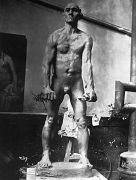 Rodin
refused to serve given expectations. The second maquette of the Calais
Monument was presented in July/August 1885, this time with a very low
pedestal, showing six separate freestanding figures at one-third height.
This time, the composition met critique, but Rodin insisted it had not
been presented to negotiate a completely new design. Rodin
refused to serve given expectations. The second maquette of the Calais
Monument was presented in July/August 1885, this time with a very low
pedestal, showing six separate freestanding figures at one-third height.
This time, the composition met critique, but Rodin insisted it had not
been presented to negotiate a completely new design.
Since 1885 he mainly worked on 'The Burghers of Calais'  and
even though a financial crisis in Calais hindered the tasks of the
committee and the realisation of the monument was not certain anymore,
Rodin finished the group in the following years. In January 1886,
three figures had been modeled in clay. In May 1887, three life-size
characters were ready in plaster. The same year, Rodin showed these three
completed figures in the Gallery Georges Petit; at the exhibition Rodin-Monet
in the same gallery in 1889, he showed the complete group. and
even though a financial crisis in Calais hindered the tasks of the
committee and the realisation of the monument was not certain anymore,
Rodin finished the group in the following years. In January 1886,
three figures had been modeled in clay. In May 1887, three life-size
characters were ready in plaster. The same year, Rodin showed these three
completed figures in the Gallery Georges Petit; at the exhibition Rodin-Monet
in the same gallery in 1889, he showed the complete group.
In 1892, the committee decided to finance the monument
finally by a national subscription and a lottery. Only in the year 1895,
more than ten years after Rodin had presented the first maquette, 'The
Burghers of Calais' were inaugurated at the entrance of the Jardin du
Front Sud, on a pedestal designed by the city architect Decroix, with
an octagonal iron gate around it.
Rodin resented this installation and returned to his
previous proposal as worded in his letter of 8 December 1893 to the Mayor
of Calais, Omer Dewavrin, his Burghers could be mounted on a very low,
"but impressive" basis on the Place d´Armes in the
centre of Calais:
"..... very low to enable the spectators to penetrate
the heart of the subject, like entombments in churches, where the group is
almost at ground level. (...) In this way, the group becomes more familiar
and plunges the viewers deeper into the tragedy and sacrifice of the
drama."
In his later conversations with Gsell, Rodin even
complained the "ugly and superfluous" pedestal of Decroix had
been forced upon him, although he would have preferred the six Burghers to
be anchored into the pavement directly – this way it would look as if
the six men would walk between the inhabitants of the city.
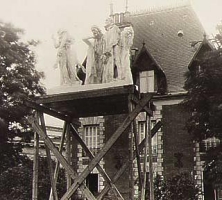 In
fact, the sculptor's grudge was mainly caused by the refusal of the Calais
City Council to position his Monument either in front of the Town Hall or
along the Route Nationale in the neighbourhood of the Pont
Richelieu – an alternative location he had suggested. He felt the
location in front of the public gardens was too much offside, as if the
City was ashamed to present its brave citizens in their state of
humiliation and despair – a suspicion he shared with Sir Schomberg
McDonnel, Secretary of the London Office of Works, who had come to view
the group in Calais and mocked Rodin's work had been installed before the
background of a public urinal and a washing room. In
fact, the sculptor's grudge was mainly caused by the refusal of the Calais
City Council to position his Monument either in front of the Town Hall or
along the Route Nationale in the neighbourhood of the Pont
Richelieu – an alternative location he had suggested. He felt the
location in front of the public gardens was too much offside, as if the
City was ashamed to present its brave citizens in their state of
humiliation and despair – a suspicion he shared with Sir Schomberg
McDonnel, Secretary of the London Office of Works, who had come to view
the group in Calais and mocked Rodin's work had been installed before the
background of a public urinal and a washing room.
As Thomas Appels demonstrates, it would be wrong to
conclude, though, that Rodin would reject the idea of a pedestal
altogether – his main concern was to reach an installation that would
allow for the highest aesthetic effect. Whereas a low placement would
bring the suffering of 'The Burghers' closer to the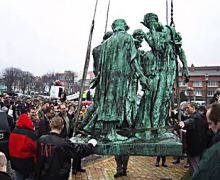 spectator and invite to direct identification, a higher position would
produce a good contrast between the lively contours and the sky.
Accordingly, the Copenhagen cast of the Burgers was put on a 1.40 meter
high base, the London version in the Victoria Towers Garden even became a
five meter high pedestal, like the Gattamelata statue by Donatello
in Padua. Before, Rodin had raised a wooden platform on his Meudon
property, to test the effect of such a high position. His
revolutionary idea of a very low placement was only realised in Calais in
1924, after the sculptor had died and the exceptional quality of his
disquieting - but meanwhile widely celebrated - monument was better
understood.
spectator and invite to direct identification, a higher position would
produce a good contrast between the lively contours and the sky.
Accordingly, the Copenhagen cast of the Burgers was put on a 1.40 meter
high base, the London version in the Victoria Towers Garden even became a
five meter high pedestal, like the Gattamelata statue by Donatello
in Padua. Before, Rodin had raised a wooden platform on his Meudon
property, to test the effect of such a high position. His
revolutionary idea of a very low placement was only realised in Calais in
1924, after the sculptor had died and the exceptional quality of his
disquieting - but meanwhile widely celebrated - monument was better
understood.
 Thomas Appel, Die Bürger von Calais, Auguste Rodins Intentionen zu
Aufstellung und Sockel, p. 70ff.
Thomas Appel, Die Bürger von Calais, Auguste Rodins Intentionen zu
Aufstellung und Sockel, p. 70ff.
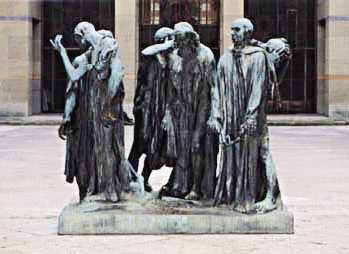 Altogether,
four life-size bronze casts were produced and erected during Rodin's
lifetime: Calais, Copenhagen, London and Mariemont in Belgium. The Ca'
Pesaro Museum in Venice owns a rare over-life-size plaster group. As
a separate project, The 'Head of Pierre de Wiessant' was enlarged to
monumental dimensions; the hand of the same figure was re-employed in 'The
Hand of God'. Altogether,
four life-size bronze casts were produced and erected during Rodin's
lifetime: Calais, Copenhagen, London and Mariemont in Belgium. The Ca'
Pesaro Museum in Venice owns a rare over-life-size plaster group. As
a separate project, The 'Head of Pierre de Wiessant' was enlarged to
monumental dimensions; the hand of the same figure was re-employed in 'The
Hand of God'.
The Burghers were also cast and distributed as single
figures. It should be noted that the names of the characters as we know
and use them today, were only attached by George Grappe, Curator of the
Musée Rodin. During Rodin's life, they were referred to as 'The Man with
the Key', etc.
Between 1895 and 1905, LeBossé produced reduced
versions of five of the six 'Burghers'; the figure of Pierre de Wiessant
was never reduced, although Rodin intended to reproduce the entire group
in this smaller format. The first examples of these small 'Burghers' were
ordered by the banker Joanny Peytel; subsequently, this edition was in
great demand among collectors, who now were able to purchase the famous
'Burghers' for an affordable price, in a size that fitted their private
housing. [Anna Tahinci, Ph. D. thesis on Rodin's Collectors, p. 39]
A selection of these small 'Burghers' was represented in an exhibition of
the Glaskastenmuseum in Marl, Germany.
BIBLIOGRAPHY (supplied by The
National Gallery of Art, Washington):
Bartlett, Truman H. "Auguste
Rodin, Sculptor." American Architect and Building News (19 January-15
June 1889): 250.
Geffroy, Gustave. "Le statuaire Rodin." Les Lettres et les Arts
(1 September 1889). In Vilain, Jacques.
Claude Monet-Auguste Rodin: Centennaire de l'exposition de 1889. Exh. cat.
Musée Rodin, Paris, 1989: 64-65. Mirbeau, Octave. "Auguste
Rodin." Le Journal (2 June 1895).
Rilke, Rainer Maria. Auguste Rodin. Trans. in G.
Craig Houston. Rodin and Other Prose Pieces. London, 1986: 35-39.
Gsell, Paul, ed. "Auguste Rodin." L'Art. Paris, 1911: 102-116,
188.
Grappe, Georges. Catalogue du Musée Rodin. Paris, 1927: 51-53.
Cladel, Judith. Rodin: The Man and His Art. Trans. S.K. Star. New York,
1917: 152-166.
Grappe, Georges. Catalogue du Musée Rodin. 5th ed. Paris, 1944:
59-62.
Elsen, Albert E. Rodin. New York, 1963: 70-87. Summary Catalogue of
European Paintings and Sculpture. National Gallery of Art, Washington,
1965: 168.
Descharnes, Robert, and Jean-François Chabrun.
Auguste Rodin. Lausanne, 1967: 106-115.
Spear, Athena Tacha. Rodin Sculpture in the Cleveland Museum of Art.
Cleveland, 1967: 40-47. European Paintings and Sculpture,
Illustrations.
National Gallery of Art, Washington, 1968: 148, repro.
Goldscheider, Cécile. "La Nouvelle Salle des Bourgeois de Calais au
Musée Rodin." La Revue du Louvre 21 (1971): 169, pl. 3.
Tancock, John. The Sculpture of Auguste Rodin. Philadelphia, 1976:
376-402.
de Caso, Jacques, and Patricia B. Sanders. Rodin's Sculpture: A Critical
Study of the Spreckels Collection. San Francisco, 1977: 204-225.
Judrin, Claudie, Monique Laurent, and Dominique Viéville. Auguste Rodin:
Le Monument des Bourgeois de Calais (1884-1895) dans les collections du...
Exh. cat. Musée des Beaux-Arts, Calais; Musée Rodin, Paris. Paris, 1977.
McNamara, Mary Jo, and Albert E. Elsen. Rodin's Burghers of Calais. New
York and Los Angeles, 1977.
Lampert, Catherine. Rodin: Sculpture & Drawings. Exh. cat. Hayward
Gallery, London, 1986: 101-115.
Miller, Joan Vita, and Gary Marotta. Rodin: The B. Gerald Cantor
Collection. The Metropolitan Museum of Art, New York, 1986: 41-71.
Le Nouëne, Patrick, and Hélène Pinet. Auguste Rodin: Le Monument des
Bourgeois de Calais et ses photographes. Exh. cat. Musée des Beaux-Arts,
Calais; Musée Faure, Aix-les-Bains. Calais, 1987. Beausire, Alain.
Quand Rodin Exposait. Paris, 1988: 95, 96, 98, 100, 105, 116, 123, 151,
157, 158, 164, 192, 201, 205, 210, 212, 213, 217, 220, 231, 237, 250, 251,
253, 260, 266, 357, 359, 366.
Fonsmark, Anne-Birgitte. Rodin: La collection du Brasseur Carl Jacobsen à
la Glypthothèque. Copenhagen, 1988: 111-115.
National Gallery of Art, Washington. National Gallery of Art, Washington,
1992: 304, repro.
Butler, Ruth. Rodin. The Shape of Genius. New Haven and London, 1993:
199-213. Sculpture: An Illustrated Catalogue.
National Gallery of Art, Washington, 1994: 200, repro.
Levkoff, Mary L. Rodin and His Time: The Cantor Gifts to the Los Angeles
County Museum of Art. Los Angeles, 1994: 92-101.
Porter, John R., and Yves Lacasse. Rodin à Québec. Quebec, 1998:
95-105.
Butler, Ruth, and Suzanne Glover Lindsay, with Alison Luchs, Douglas
Lewis, Cynthia J. Mills, and Jeffrey Weidman. European Sculpture of the
Nineteenth Century. The Collections of the National Gallery of Art
Systematic Catalogue. Washington, D.C., 2000: 345-348, color repro.
|